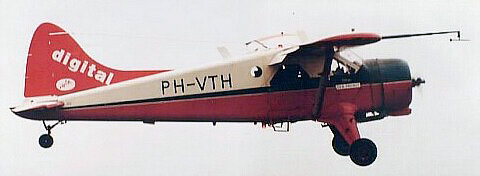The early history of the FDC toolbox
This history of this toolbox started in april 1992, when an autopilot design project was initiated at the Stability and Control department of the Faculty of Aerospace Engineering of Delft University of Technology.
The project involved two sets of control laws for the De Havilland DHC-2 'Beaver' aircraft: a 'classical' root-locus design and a modern adaptive controller. In order to speed up the design process, all off-line analysis was performed within the Matlab/Simulink environment, which resulted in a collection of simulation models and tools that, in retrospect, can be regarded as the "1.0-release" of what would later be known as the 'Flight Dynamics & Control toolbox'.

DeHavilland DHC-2 'Beaver' laboratory aircraft, Delft University of Technology
The resulting MSc-thesis attracted so much attention within the Faculty of Aerospace Engineering that it was decided to create an improved version of the toolbox. This version, called 'Beaver Simulation Toolbox 1.1', or 'BEAST 1.1', was released in 1994. It contained significant improvements regarding the model structure and the documentation of the source-code.
When the 'Beaver' aircraft was retired in favor of a new Cessna Citation II business jet, other simulation tools which were based on the BEAST package took over the role of this toolbox within the Faculty. Nevertheless, an improved Matlab 4 compatible version was created and distributed to a wide audience, including people from outside the University. The new version was released in 1997 as 'Flight Dynamics and Control Toolbox 1.2', featuring enhanced on-line help facilities, improved autopilot models (including a simplified mode-controller), better data input routines, and new data-processing tools. The MSc-thesis was transformed into a technical report that could also serve as user-manual and reference guide for the toolbox.
Transition to an Open Source project
To further widen the user-base, the package was uploaded to the public FTP-servers of The Mathworks in May 1997. Later that year FDC 1.3 was created, offering Matlab 5 compatibility, improved cross-platform behavior, a further improved user-interface, and better installation routines. This version also included an HTML-based on-line help system.
In april 1998 the first version of this website was opened, triggering an unexpectedly large response from many people all over the world. This made me decide to start the FDC 2 development, which I hoped to finish within a reasonable timeframe. Obviously this turned out to be way too optimistic, but despite the huge delay, this project has never actually come to a complete stand-still. Over the years, several maintenance releases of FDC 1.3 have been distributed, related documentation has been made available for download, and the website has gone through some major revisions.
Even more important is the transition towards a genuine Open Source project, which allowed me to take advantage of the services offered by SourceForge. The first concrete results have been the release of the general-purpose Simulink blockset DUBSI, which is a derivative work from the FDC 2 project, and the early beta of the upcoming FDC 1.4 interim release, which can be obtained from the Dutchroll CVS tree at SourceForge.
See the News page for the latest developments in this project. Thank you all for your support and patience!

